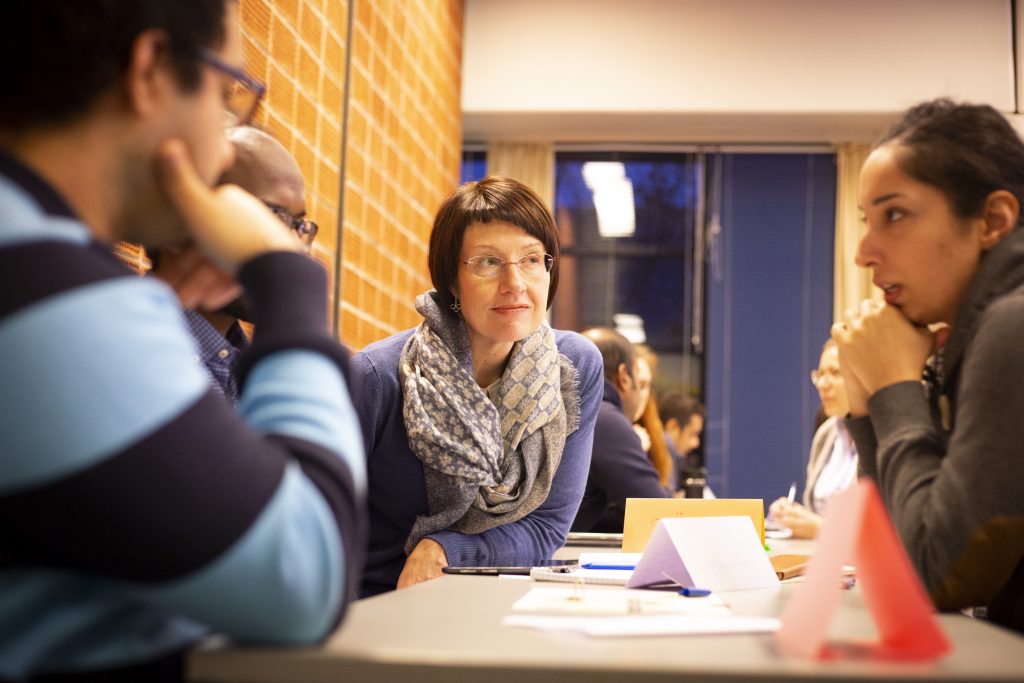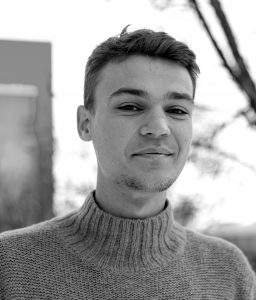Amaya Garcia Márquez is currently in Oulu for an exchange period from Spain. She says she came to have a new Finnish experience. She has already lived in Finland for approximately 10 months altogether and holds a B2 language certificate. In 2015, in her last year of high school, she was offered a scholarship and asked to put in order countries she would like to go for an exchange to by preference. She listed Finland as her number one, leaving the second place to South Africa.
“It was a feeling of connection, even though I did not know much about Finland. I arrived on the 21st of August [in 2015] without speaking a single word and school started on the 23rd of August completely in Finnish.”
Offering a view from a different learning level, a student who has recently made the first step and started studying the language is Alexander Csepregi. He is from a geographically distant yet linguistically rather close Hungary and currently coaches basketball and studies at our university.
As he says, he is new to the country and to the language, currently being able to use simple phrases and introduce himself in Finnish. He mentions that Hungarians see Finns as their distant brothers living in the cold, yet he doesn’t consider the language similar sounding.
“A friend of mine from Hungary bought a house way up north and he has met some Sami people and heard them speak. He told me he felt like he was listening to Hungarian, except he could not understand, which was apparently a strange experience. On the other hand, he agreed with me that Finnish doesn’t sound like Hungarian to us at all.”
Waldo Seppä offers yet another distinct perspective on the topic of Finnish learning. Introducing himself as “German speaking South African with a Finnish father” might suggest why that is. Waldo Seppä mentions that his level of fluency truly depends on the period of his life we are discussing about, since his life in Finland and moving in and out of the country
“In South Africa I’m always the ‘Finn’, and in Finland I’m always the ‘South African’. My relationship with Finnish has always been up and down. Apparently, my dad even used to speak to me in Finnish when I was very young, yet I don’t remember this.”
For us to better understand what the Finnish language classroom looks like from the other side of the teacher’s table, we turned to university lecturer Anne Koskela for a few questions. She isn’t a new name to neither Finns nor students from abroad, since she teaches the Finnish language both as a native and as a second language.
After graduating from the University of Oulu, Anne Koskela gained her first experience with teaching Finnish as a second language to adult refugees. Afterwards, she taught foreigners in general, in a course preparing them for a professional life in Finland. Later, she found her way into teaching at the university as well and is still on that path.
Is Finnish really that difficult? Yes and no
“Of course, we, the Finnish teachers, don’t want to say Finnish is hard,” Anne Koskela says.
According to her, seeing Finnish as different rather than difficult is a better approach. The language is indeed not part of the Indo-European group, which is unusual for Europe. While she mentions that learners from Hungary may have a slight advantage with understanding the language structures, the favor is still rather small and the speakers may still struggle in other aspects. Additionally, coming from a language differentiating short and long sounds may help as well.
However, where Anne Koskela sees the biggest advantage is having a learning experience.
“I think it is also a question of learning strategies and learning itself. If you already have experience with language learning and have studied other foreign languages before, it makes it easier to learn Finnish as well.”
“The difference between spoken and written language plays a big role in what makes it difficult.”
Alexander Csepregi confirms the previous ideas by mentioning that the Finnish language logic is not strange to him as a Hungarian, and he indeed finds the separate sounds similar, which he considers an advantage. Being an agglutinative language, also Hungarian is capable of building unusually long words via affixes. He mentions that occasionally he translates his Finnish materials to Hungarian rather than English, since it makes more sense.
However, with vocabulary his background brings him only a minimal advantage. Additionally, Alexander Csepregi finds another aspect of Finnish troublesome.
“The difference between spoken and written language plays a big role in what makes it difficult. Sometimes my colleagues, other basketball teachers, text each other, and not even Google translate recognizes the sentences they write.”
Similarly, Waldo Seppä looked at both sides of the coin of his learning process.
On one hand, he appreciates the straightforwardness of Finnish. He compares it to English and French, where a learner has to memorize the use of prepositions in various cases, while in Finnish one can quickly start logically building the words together. However, that also brings challenges.
“The difficulty comes when you get a crazy long word, and you are just… clueless. What is also hard is when you start getting into very complex grammar. But that part, the advanced grammar, is what makes Finnish so difficult, and people tend to focus on that.”
While he mentions that he doesn’t see this advanced grammar as crucial for getting fluent, he understandingly concludes that he can see why people would call Finnish a hard language.

Courses as a platform to speak
Amaya Garcia Márquez surprises many people with her level of fluency after a short time in Finland, however, she can definitely remember and see the strenuous side of the language as well. She speaks English, French, Finnish, and Spanish and mentions that Finnish is very distant from the other three. Especially in the beginning she found the learning as demotivating.
“I had moments when I felt frustrated with myself for not being able to learn Finnish, and I thought I would never speak it. That was the hardest part, the mental side, the frustration,” she says.
Amaya Garcia Márquez points out she has learned most of what she currently knows by using the language. However, when her peers during her high school exchange year had Finnish classes, she had sessions with a Finnish teacher. Besides getting learning recommendations, she considers the biggest advantage being the fact that the teacher would never switch to English and continued talking to her in her target language. In time, she picked up more and more vocabulary that she started trying to put into sentences. She mentions that she never studied grammar per se, and therefore usually recognizes instinctively whether a sentence sounds correct or not.
“That was the hardest part, the mental side, the frustration.”
On her road from a beginner to being mistaken for a person from Turku, Amaya Garcia Márquez was driven by her motivation.
“I wanted to learn. I wanted to belong to the place. All my friends would talk Finnish during lunch, and even though they talked to me in English, I wanted to have the feeling of understanding the world around me.”
Waldo Seppä, who has attended several Finnish courses in the past, currently attends the “Opettajaksi Suomeen” course at our university. However, what he considers the main advantage is the opportunity to speak and practice, since he often found himself gravitating towards the English speaking circles while in Finland.
“Courses really provide an opportunity, where you are really speaking Finnish, and you have a person that is always there to help you. Also, after my first two years in Finland, I found myself being professional at answering questions about where I am from and introducing myself. In a Finnish course you always get the chance to speak about different topics as well.”
“However, knowing friends that have learnt Finnish, I know it is possible and extremely fulfilling.”
Seppä is not the only one who sees the Finnish courses as a positive experience. Alexander Csepregi happily concludes he recently finished the “Survival Finnish” course offered at our university. He is currently taking “Beginner’s Finnish” and mentions it is mostly in official Finnish, and sometimes the puhekieli versions of words are mentioned. The spoken language is, in fact, what he considers the biggest learning challenge. What he appreciates about the courses is the foundations they offer him.
Alexander Csepregi says his plan is to keep taking courses until he fails a final exam from one of them. While he is currently not sure how far that will get him, being in first year of his English bachelor’s program in Oulu, he dreams of high goals.
“It would be incredible to learn it [Finnish] fluently. I have Finnish friends, and if I would just show up and speak it, their jaws would drop. I would love to impress them like that,” Alexander Csepregi says, and adds that “if you want to learn a language just to add it to your resume, pick a different one. However, knowing friends that have learnt Finnish, I know it is possible and extremely fulfilling.”
Anne Koskela has a unique insight into learning the language, as both native and foreign. She mentions that the two categories of learning are not completely different. In the beginning, the foreign learners obviously focus on snowballing vocabulary, with time they start to practice topics similar to the ones offered in the Finnish language courses for natives studying for their master’s programs.
“In the conversation course, there are speaking exercises in different situations, for example, in working life. In other courses, we also write academic writing with the students. Both of those we practice with Finnish students as well.”
With Finnish being depicted as a difficult language, hearing that the Finnish students practice similar things in the compulsory communication courses may be motivating for foreigners who are learning Finnish.
Getting over the fear
Waldo Seppä, being further down the road of cracking the code of the Finnish language, has an additional advice as well.
“I can not stress this enough: learn vocabulary. Start talking like a three-year-old. You think you sound stupid, but that is how you learn. The more words you know, the more you can follow the conversation around you, and if you don’t know a word, write it down. Finally, don’t be afraid to speak. You’re going to make mistakes a lot and you know that is okay,” he explains and gives an example: “if someone is trying to learn your native language, and they speak it to you, you don’t care if they sound odd. People need to get over the fear of making mistakes. A three-year-old often makes mistakes too, but they will learn the language faster because they don’t care. Just practice.”
“Just go ahead and try. Even though in some moments you will feel down because you don’t understand, and a single word has 6 different meanings, and you feel like you can never learn the language. But you do not need a complete proficiency to speak and understand. Just go for it, it is not impossible, and it connects you with the culture, and people here feel happy and proud when you speak the language,” Amaya Garcia Márquez says.
All interviewed students agree on the fact that getting to speak the language is a massive advantage of each course.
Anne Koskela also agrees with the point and encourages the students to not be afraid of mistakes, and to not be afraid of speaking to Finns. Additionally, she shares a message for the natives as well.
Similarly to getting to speak in the courses, the natives can help their peers improve their skills simply by speaking with them.
“It is important from our side, that we do not switch immediately to English when we see they are just learning. Sometimes we want to be polite and switch to English, and maybe even because we want to practice our English skills with foreigners. I understand it is easier to operate in English in some situations, but it could be a decision that you could talk together for 5 or 10 minutes during lunch break in Finnish.”
Read more: Hi, 5 ways to improve your Finnish, ”Could your classmates translate this for you?” – The beauty and pain of multilingualism at the University of Oulu


